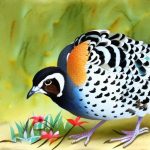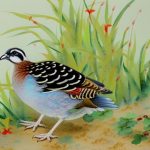Chinese Painted Quail, also known as King Quail or Button Quail, are small, ground-dwelling birds native to Southeast Asia and Australia. They are popular among aviculturists for their colorful plumage and small size, making them an attractive addition to aviaries and collections. Chinese Painted Quail are known for their gentle and social nature, making them a great choice for bird enthusiasts looking for a unique and low-maintenance pet.
These quails are typically around 4-5 inches in length and come in a variety of colors, including silver, cinnamon, blue, and white. They are known for their distinctive markings, with the males often displaying more vibrant colors and intricate patterns compared to the females. Chinese Painted Quail are ground-dwelling birds, preferring to forage for food on the floor of their enclosure. They are also known for their distinctive call, which is often described as a soft, repetitive chirping sound. These quails are relatively easy to care for and can thrive in a variety of environments, making them a popular choice for both experienced and novice bird keepers.
Table of Contents
- 1 Selecting Breeding Stock
- 2 Housing and Nesting Requirements
- 3 Breeding and Incubation Process
- 4 Caring for Chicks
- 5 Health and Disease Management
- 6 Tips for Successful Breeding
- 7 FAQs
- 7.1 What is the breeding season for Chinese painted quail?
- 7.2 How many eggs do Chinese painted quail lay?
- 7.3 What is the incubation period for Chinese painted quail eggs?
- 7.4 What is the best way to incubate Chinese painted quail eggs?
- 7.5 How long does it take for Chinese painted quail chicks to mature?
- 7.6 What is the ideal diet for breeding Chinese painted quail?
Key Takeaways
- Chinese Painted Quail are small, colorful birds native to East Asia, known for their gentle nature and beautiful plumage.
- When selecting breeding stock, look for healthy, active birds with vibrant colors and good body conformation.
- Provide Chinese Painted Quail with a spacious and secure enclosure, including nesting boxes and suitable substrate for nesting.
- The breeding and incubation process involves providing a suitable environment for mating, collecting and incubating eggs, and caring for the hatchlings.
- Care for chicks by providing a warm and safe environment, feeding them a balanced diet, and monitoring their growth and development.
- Health and disease management for Chinese Painted Quail involves regular observation, proper nutrition, and prompt treatment of any signs of illness.
- Tips for successful breeding include providing a balanced diet, maintaining a clean environment, and monitoring breeding pairs for compatibility and productivity.
Selecting Breeding Stock
When selecting breeding stock for Chinese Painted Quail, it is important to choose healthy, vibrant birds with good genetic traits. Look for birds that are active, alert, and have bright, clean plumage. Avoid birds that appear lethargic or have any signs of illness or injury. It is also important to consider the age of the birds, as younger birds are generally more fertile and have a higher chance of successful breeding.
When selecting breeding stock, it is also important to consider the genetic diversity of the birds. Inbreeding can lead to genetic defects and health issues in offspring, so it is important to choose birds from different bloodlines to ensure genetic diversity. Additionally, consider the temperament of the birds, as aggressive or overly dominant birds may not be suitable for breeding. By carefully selecting breeding stock with good genetic traits, health, and temperament, you can increase the likelihood of successful breeding and produce healthy offspring.
Housing and Nesting Requirements
Chinese Painted Quail are relatively small birds and can be housed in a variety of enclosures, including aviaries, cages, or outdoor pens. When housing Chinese Painted Quail, it is important to provide adequate space for the birds to move around and forage for food. A spacious enclosure with plenty of hiding spots and natural materials such as grass, leaves, and branches will help create a naturalistic environment for the quails.
For nesting requirements, Chinese Painted Quail prefer to nest on the ground in a secluded area. Provide nesting boxes or shelters filled with soft bedding material such as straw or shredded paper to create a comfortable and secure nesting environment for the birds. It is important to provide multiple nesting sites to prevent competition among breeding pairs and ensure that each pair has a suitable place to lay their eggs.
In addition to nesting boxes, it is important to provide a shallow dish of clean water for bathing and drinking, as well as a variety of perches and hiding spots to encourage natural behaviors and reduce stress. By providing a suitable housing environment with ample space, natural materials, and nesting sites, you can create an ideal setting for successful breeding and nesting behavior in Chinese Painted Quail.
Breeding and Incubation Process
Breeding Chinese Painted Quail can be a rewarding experience for bird enthusiasts. To encourage breeding behavior, it is important to provide a suitable environment with ample space, natural materials, and nesting sites. Once breeding pairs have formed and nesting behavior is observed, it is important to monitor the eggs closely and provide proper care during the incubation process.
Chinese Painted Quail typically lay small, speckled eggs that require careful handling during the incubation process. It is important to collect the eggs daily to prevent them from being damaged or eaten by other birds in the enclosure. Once collected, the eggs should be placed in an incubator set at a temperature of around 99-100 degrees Fahrenheit with high humidity levels. It is important to regularly monitor the temperature and humidity levels to ensure optimal conditions for egg development.
The incubation period for Chinese Painted Quail eggs is approximately 16-18 days. During this time, it is important to maintain stable environmental conditions and avoid any disturbances that may disrupt the incubation process. Once the eggs hatch, it is important to provide a warm, safe environment for the chicks to grow and develop. By carefully monitoring the breeding and incubation process and providing proper care for the eggs and chicks, you can increase the likelihood of successful breeding and produce healthy offspring.
Caring for Chicks
Caring for Chinese Painted Quail chicks requires careful attention to their specific needs during the early stages of development. Once the chicks have hatched, it is important to provide a warm, draft-free environment with access to clean water and high-quality chick starter feed. It is important to monitor the chicks closely and provide supplemental heat using a heat lamp or brooder to maintain optimal temperature conditions for their growth and development.
In addition to providing proper nutrition and warmth, it is important to handle the chicks gently and minimize stress during the early stages of life. Avoid overcrowding in the brooder or enclosure and provide ample space for the chicks to move around freely. It is also important to monitor the chicks for any signs of illness or injury and provide prompt veterinary care if needed.
As the chicks grow and develop, it is important to gradually introduce them to a balanced diet of seeds, grains, insects, and fresh greens to ensure proper nutrition and healthy growth. By providing attentive care, proper nutrition, and a suitable environment for growth and development, you can ensure that Chinese Painted Quail chicks thrive and mature into healthy adults.
Health and Disease Management

Maintaining the health and well-being of Chinese Painted Quail requires regular monitoring for signs of illness or disease. It is important to provide a clean environment with access to fresh water, high-quality feed, and natural materials such as grass and leaves to promote natural behaviors and reduce stress. Regularly inspect the birds for any signs of illness or injury, such as lethargy, loss of appetite, abnormal droppings, or respiratory issues.
In addition to regular monitoring, it is important to practice good hygiene by regularly cleaning the enclosure, nesting boxes, feeders, and water dishes to prevent the spread of disease. Provide regular dust baths or access to fine sand to help control parasites such as mites and lice. It is also important to quarantine new birds before introducing them to an existing flock to prevent the spread of disease.
If illness or disease is suspected, it is important to seek veterinary care promptly to diagnose and treat any health issues. By practicing good hygiene, regular monitoring, and prompt veterinary care when needed, you can help maintain the health and well-being of Chinese Painted Quail in your care.
Tips for Successful Breeding
Successfully breeding Chinese Painted Quail requires careful planning, attentive care, and proper management of breeding pairs. To increase the likelihood of successful breeding, it is important to provide a suitable environment with ample space, natural materials, nesting sites, and proper nutrition. Monitor breeding pairs closely for signs of courtship behavior and nesting activity.
It is also important to carefully monitor the incubation process by collecting eggs daily and providing optimal conditions in an incubator for successful hatching. Once the chicks have hatched, provide attentive care by maintaining proper temperature conditions, nutrition, and handling to ensure their healthy growth and development.
To maintain the health and well-being of Chinese Painted Quail, practice good hygiene by regularly cleaning the enclosure and providing access to fresh water, high-quality feed, natural materials, and dust baths. Regularly monitor the birds for signs of illness or disease and seek veterinary care promptly if needed.
By following these tips for successful breeding and attentive care, you can enjoy the rewarding experience of breeding Chinese Painted Quail while maintaining their health and well-being in your care.
If you’re interested in breeding Chinese painted quail, you may also want to consider the best flooring options for your quail coop. Poultry Wizard offers a helpful article on the topic, discussing the pros and cons of different flooring materials and how to maintain a clean and comfortable environment for your quail. Check out their article on Poultry Wizard for more insights into creating an ideal living space for your quail.
FAQs
What is the breeding season for Chinese painted quail?
Chinese painted quail typically breed during the spring and summer months, with peak breeding activity occurring from April to August.
How many eggs do Chinese painted quail lay?
A female Chinese painted quail can lay between 6 to 12 eggs in a clutch, with an average of 8 eggs being the most common.
What is the incubation period for Chinese painted quail eggs?
The incubation period for Chinese painted quail eggs is approximately 17 to 18 days.
What is the best way to incubate Chinese painted quail eggs?
Chinese painted quail eggs can be successfully incubated using a small egg incubator set at a temperature of 99.5 degrees Fahrenheit and a humidity level of 50-60%.
How long does it take for Chinese painted quail chicks to mature?
Chinese painted quail chicks typically mature and reach sexual maturity at around 6 to 8 weeks of age.
What is the ideal diet for breeding Chinese painted quail?
A balanced diet for breeding Chinese painted quail should include a high-quality game bird or quail feed, supplemented with fresh greens, insects, and grit for digestion. Additionally, providing a calcium source such as crushed oyster shell or eggshells is important for egg production.
Meet Walter, the feathered-friend fanatic of Florida! Nestled in the sunshine state, Walter struts through life with his feathered companions, clucking his way to happiness. With a coop that’s fancier than a five-star hotel, he’s the Don Juan of the chicken world. When he’s not teaching his hens to do the cha-cha, you’ll find him in a heated debate with his prized rooster, Sir Clucks-a-Lot. Walter’s poultry passion is no yolk; he’s the sunny-side-up guy you never knew you needed in your flock of friends!







